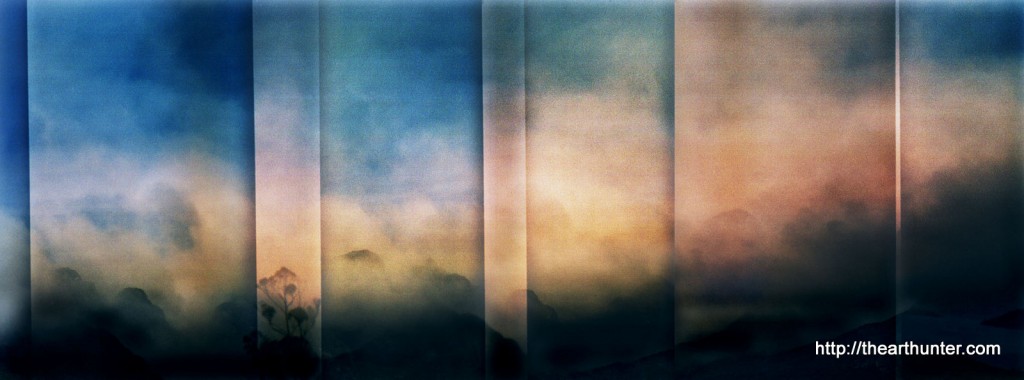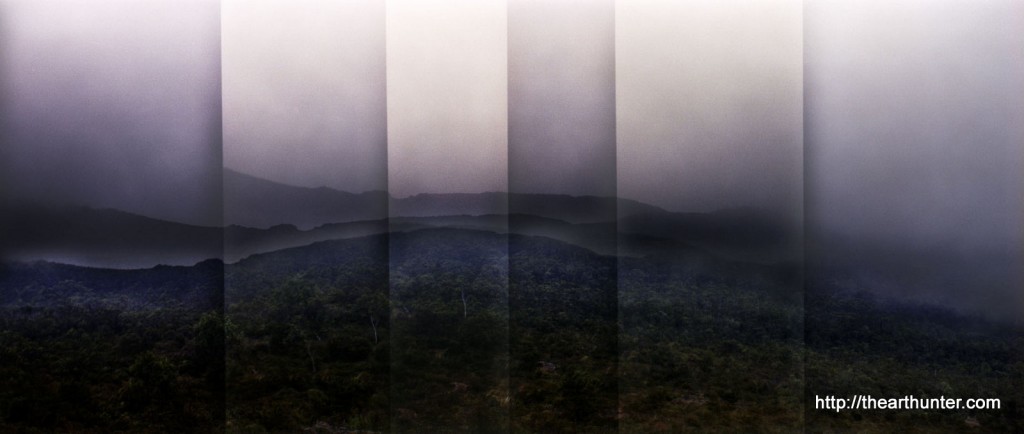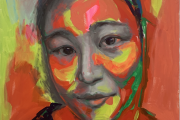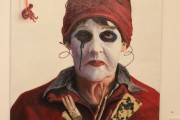Alice Blanch is an emerging South Australian Artist whose work is drawing a lot of attention due to the new and exciting techniques she uses in handling old cameras equipment and materials. Her beautiful landscapes capture the eye and enthrall the senses. I wrote briefly about her work in 2012. Her work has been selected for the Emma Hack Art prize in the current Fringe festival.
When did you first become interested in photography and how did you discover your particular style?
Looking back now I can see that I was always interested in photography, I just didn’t realise at the time. I used to love looking at the old black and white photographs of my grandparents and parents, and I used to always bug mum and dad to let me take ‘just one more photograph’ on the family film camera. It wasn’t until year 12 that I realised it was something that I was really interested in; we had to study one ‘Science’ subject at school and I decided to take a black and white photography class externally (it was considered a science class because of the chemistry!). I really enjoyed this class, learning how to process and develop film in the darkroom. After year 12 I decided to continue with the ‘arts’ thing as I wasn’t sure what else to do and then in my final year of my undergraduate degree at UniSA I came across a Box Brownie camera and everything started to fall into place.
I guess I came across my style by looking at a lot of other artists work, seeing how they captured the world and questioning if I liked it or not and why I liked it or not. This gave me a clear understanding about what I wanted to capture and what to look for when I was out with my camera. But really I think that my style or vision for my photographs is just something inside of me that has always been there and it is just luck that I have found a way to express this vision so truthfully.
Could you describe how you produce your works?
All my work is shot on film in antique cameras; I am always taking photographs and use a wide range of films and formats. Once I have finished a roll of film I either process it myself (if its black and white) or process it at Atkins Technicolour Photo Lab here in Adelaide (if its colour). I then scan my negatives onto the computer and work with them in Photoshop before printing them on fine art paper. I also like to work in the darkroom on the odd occasion printing silver gelatin images, mucking around with paper negatives, creating cyanotypes and I also enjoy using the 18th Century Wet Plate process.
My ‘Box Brownie Panoramas’ are all shot in-camera on 120 colour or black and white film. To create the panoramic affect I capture multiple, overlapping exposures on the photographic film. This is done by taking one exposure in the brownie, winding the film through the back of the camera randomly (not enough to get to the next exposure) and moving the camera slightly and then taking another exposure. I repeat this about 4-6 times to create one of the panoramas. I try not to think about the winding part too much as I like to keep it quite random and unexpected.
Why do you choose to use a brownie box camera, does it hold any special significance?
I love using the brownie cameras because they are so simple; it’s a box with a whole it in it and a lens- basically one step up from a pinhole camera! The brownie cameras don’t require too much fussing over and are really sturdy so they can be dropped and kept in a backpack without having to worry about them.
I also really like the cameras for their history. The box brownie cameras were introduced in the1900’s and were the first cameras that were designed for the everyday person/family; the brownie made photography available for everyone, not just the rich and well off types. They played a pretty major part in the history of photography but are usually overlooked because they were so readily available and considered cheap and simple now days.
Did you study Art formally? Where did you study and what did you gain from this study?Yes, I studied a Bachelor of Visual Arts at the South Australian School of Art (located at the UniSA City West campus), majoring in photography from 2008-2010. I then moved to Hobart in 2012 to study my Honours in photography at the Tasmanian School of Art.
I gained a lot from my study. Although it was very hard and sometimes very frustrating, my four and a bit years of study have really helped me in more ways that I can express. My Honours year taught me how to express myself in writing, which I think is one of the hardest things a visual artist can do! Going to Uni has also given me a great network of friends who are also local artists as well as teachers who I often call upon for advice and support.
What is it about landscape photography that you enjoy?
I just love the natural landscape in general. I am an outdoors kind of person, I love hiking, camping, cycling and travelling in areas of nature. When I can’t leave the city the sky is my substitute and my connection to the natural world. My artworks revolve around the landscape because this is where I love to be. When looking at other artists and their work I enjoy all subject matters, not just ones depicting the landscape.
Do you digitally alter your work much before it is printed?
Once I have scanned my negatives into the computer I work with them in Photoshop. I use Photoshop in a very basic way, mainly working with and editing the contrast and colour balance of images. Not too different than what I do when I am working in the darkroom.
If you were to give some advice to young artists interested in photography what would it be?
My advice would be to just go out and take photographs!! Its one of the scariest things- actually leaving the house, dedicating time to go for a walk down the street or in the park and exploring, taking photographs along the way. The more you take the more you will realise what it is that you like and don’t like and you will learn for next time what to do/what not to do and what subject to focus on etc.
I would also have to say: have a go with shooting film! Its really rewarding and wonderful, even when you get a whole roll of film back and every image is black except one- but just think how special is that one image to still be there!? Even if you love digital photography, give film a go and you might be surprised that you enjoy taking the time to get the right shot the first time and even having to wait to see the negatives for days or weeks at a time.
Which artists do you admire and why?
I admire Bill Henson because his work is really beautiful and emotive. I think he is a wonderful artist who was clear about his photographic vision from early in his career and even through all the mess he has been involved in he is still clear and true to his vision.
Most of the artists I get my inspiration from where painters come from the Romantic art period. There are also a lot of contemporary Australian artists working around this Romantic theme again that inspire my work.
You can view more of Alice’s work on her website Here







